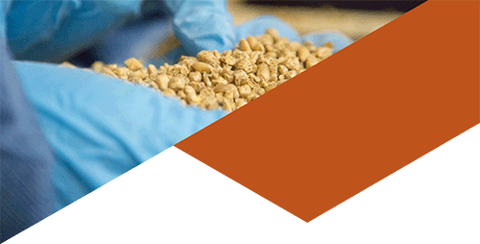

Vet Corner
Mycotoxins in Poultry
Dr. Kayla Price and Dr. Alexandra Weaver
What are mycotoxins?
Feedstuffs are often contaminated with multiple mycotoxins. Mycotoxins are produced by moulds during times of stress whether due to disease or, most importantly, due to the surrounding environment. Moulds can produce mycotoxins in the field due to different growth conditions. For example, wet or drought conditions may encourage different mycotoxin production. Alternatively, moulds can produce mycotoxins during storage conditions where there may be excess moisture or high oxygen penetration. Storage moulds can occur alone or in addition to the mycotoxin contamination from the field. As a result, in a single feedstuff one mould could produce several mycotoxins or there could be several moulds each producing a mycotoxin. This situation could result in any commodity being contaminated by multiple mycotoxins whether it is due to field conditions or due to storage. Once a mycotoxin has developed they can remain for a long time as they are highly stable.
There are several mycotoxin detection strategies available that vary in cost, sensitivity and accuracy.
The best method for sensitivity and accuracy is liquid chromatography-tandem mass spectrometry (LC-MS/MS)
This strategy can screen for multiple mycotoxins simultaneously in grains and finished feeds. Other strategies used include an ELISA-based lateral flow test. This test is a quick and easy way to screen certain grains for a limited number of mycotoxins. This method is a rapid and inexpensive method but is not as sensitive as other methods.
Mycotoxin survey in poultry feeds
Each year, Alltech conducts a harvest analysis to determine the potential mycotoxin risk in new crop grains and forages. This survey is done in many different geographical regions. Based on the feed and grain samples received the survey is also able to look at different feedstuffs for various animal species. The global results for poultry finished feeds encompasses three major regions (USA, Europe and Asia) and a total of 212 finished feed samples from October 2019 to March 2020. Mycotoxin analysis was conducted at the Alltech 37+ Analytical Services Laboratory in Lexington, Kentucky or in Dunboyne, Ireland. Alltech 37+ makes use of high-tech screening techniques based on the LC-MS/MS method. With this method, the lab can detect over 50 mycotoxins in animal feed.
To allow for interpretation of these results, the Alltech Mycotoxin Management team has developed the risk equivalent quantity (REQ).
The REQ is an evaluation of the total toxicity of a given mycotoxin mixture based on the amount of each individual mycotoxin present and its relative toxicity. This calculation can be tailored to the specific species and age group. The age and the type of bird has an impact on the susceptibility to the risk of a mycotoxin challenge. As a result, some birds may be able to withstand more of a challenge than others.
Why should we care about mycotoxins in poultry?
Sensitivity to mycotoxins in poultry can be different depending on multiple factors such as the mycotoxin type, bird’s age, health status or species. Additionally, mycotoxin contamination in finished feed may occur at low, medium or high-risk levels to poultry production. It is commonly thought that mycotoxins are only an issue for long-lived poultry, such as layers and breeders, and are not a challenge in short-lived poultry, such as broilers. Mycotoxin contamination can build-up over time and become a problem but short-term exposure, whether to high or low levels, can also pose a risk to poultry production. The short-term exposure or exposure to low levels of mycotoxins can be a common occurrence in poultry production but diagnosis is difficult. Whether at low, moderate or high risk in finished feeds mycotoxins have been shown to have an impact on bird health and performance.
Mycotoxins, when ingested, act to impair rapidly dividing cells.
These rapidly dividing cells are found in many parts of poultry including the skin, gastrointestinal tract, reproductive tract, immune system and skeletal system. Different mycotoxins can impact these systems either directly or indirectly and, ultimately, have an impact on production and performance. Different challenges that can relate to mycotoxins include mouth lesions, altered liver and pancreatic function, damaged intestinal integrity, reduced feed intake, reduced nutrient absorption, immunosuppression and wet manure.
The major mycotoxins identified in the poultry finished feed sample analysis were Type B Trichothecenes (DON group), Fumonosins, Fusaric Acid and emerging mycotoxins. In the USA, some Ergot toxins were found with the maximum level detected being a higher challenge level. Type B Trichothecens, Fumonosins and Ergot toxins negatively impact the gastrointestinal tract in various ways. Additionally, these mycotoxins have been found to suppress the immune system. As a result, these mycotoxins have a direct impact on intestinal health and how the bird can protect itself. Sometimes at realistic low-level risk these mycotoxins can impact the immune system but may not impact observable performance. When the immune system is suppressed there is a greater risk for secondary infections whether bacterial or viral.
These mycotoxins can cause extensive damage on their own, especially at high risk levels, but can cause even more damage when found in combination. Even if there is a low risk level for a mycotoxin the multiple mycotoxin contamination can present a medium or higher risk situation. This type of multiple contamination has been shown to lead to many issues including: 1) increase intestinal cell damage; 2) decrease intestinal cell growth; 3) increase intestinal permeability; 4) impair intestinal recovery; 5) indirectly alter microbial communities; and, 6) suppress immune protection.
Overall, the finished feed samples that were collected showed the highest risk in the USA samples. Nevertheless, grains originating from Europe and Asia showed low and moderate risk. The low and moderate risk levels can still impact intestinal health and the immune system in poultry production. Managing mycotoxin contamination requires a multi-factorial approach that includes diluting the contaminated grain to use of broad-spectrum mycotoxins binders.
The USA represented 126 finished feed samples and showed an average number of mycotoxins per sample to be 9.04 with a range of 4 to 16. The dominant mycotoxins groups were Type B Tricothecenes with an average of 769.7ppb, Fumonosins with an average of 1350.1ppb and Fusaric acid with an average of 130.9ppb. Other mycotoxins found, albeit at lower levels, were different emerging mycotoxins with an average of 79.1ppb and zearalenones with an average of 37.8ppb. Interestingly, the maximum level detected for Type B Tricothecenes was 3021ppb and the maximum level detected for Fumonisins was 9930ppb.
Despite wheat, oats and barley not being commonly used in USA feeds some will be used in finished feeds depending on the price. In these types of grains Ergot toxins can be a risk. In the finished feed samples Ergot toxins had an average value of 11.9ppb but a maximum level detected of 627ppb. Regardless, the combination of these mycotoxins will add to the risk. When looking at the finished feed sample REQ values to determine a low, moderate or high risk to production parameters for starter poultry, broilers and layers there were different risk percentages found. If the finished feeds were to be used for starter poultry then 65.9% of the samples showed a higher risk REQ compared to 39.7% or 30.2% in layer or broiler feeds, respectively. If the finished feeds were to be used for starter poultry then 24.6% of the samples showed a moderate risk REQ compared to 46.8% or 34.1% in layer or broiler feeds, respectively. If the finished feeds were to be used for starter poultry then 9.5% of the samples showed a lower risk REQ compared to 13.5% or 35.7% in layer or broiler feeds, respectively.
Europe represented 48 finished feed samples and showed an average number of mycotoxins per sample to be 5.06 with a range of 1 to 11. The dominant mycotoxins groups were Type B Tricothecenes with an average of 131.7ppb, Fumonosins with an average of 523.0ppb, Fusaric acid with an average of 99.4ppb and emerging mycotoxins with an average of 80.8ppb. Interestingly, the maximum level detected for Type B Tricothecenes was 1044ppb and the maximum level detected for Fumonosins was 3314ppb.
Regardless, the combination of all of these mycotoxins will add to the risk. When looking at the finished feed sample REQ values to determine a low, moderate or high risk to production parameters for starter poultry, broilers and layers there were different risk percentages found. If the finished feeds were to be used for starter poultry then 39.6% of the samples showed a moderate risk REQ compared to 27.1% or 8.3% in layer or broiler feeds, respectively. If the finished feeds were to be used for starter poultry then 56.3% of the samples showed a lower risk REQ compared to 70.8% or 91.7% in layer or broiler feeds, respectively.
Asia represented 38 finished feed samples and showed an average number of mycotoxins per sample to be 6.74 with a range of 1 to 12. The dominant mycotoxins groups were Type B Tricothecenes with an average of 109.5ppb, Fumonosins with an average of 493.2ppb and Fusaric acid with an average of 97.8ppb. Other mycotoxins found, albeit at lower levels, were different emerging mycotoxins with an average of 56.3ppb. Interestingly, the maximum level detected for Type B Tricothecenes was 449ppb, the maximum level detected for Fumonosins was 1390ppb, the maximum level detected for Fusaric acid was 693ppb and the maximum detected level for emerging mycotoxins was 1125ppb.
Regardless, the combination of these mycotoxins will add to the risk. When looking at the finished feed sample REQ values to determine a low, moderate or high risk to production parameters for starter poultry, broilers and layers there were different risk percentages found. If the finished feeds were to be used for starter poultry then 34.2% of the samples showed a moderate risk REQ compared to 28.9% or 7.9% in layer or broiler feeds, respectively. If the finished feeds were to be used for starter poultry then 55.3% of the samples showed a lower risk REQ compared to 63.2% or 86.8% in layer or broiler feeds, respectively.
Different growing conditions, harvest dates and stressors to the crops can lead to different mycotoxin challenges around the globe. From the analysis of finished feeds in USA, Europe and Asia the mycotoxin challenge is seen to vary.